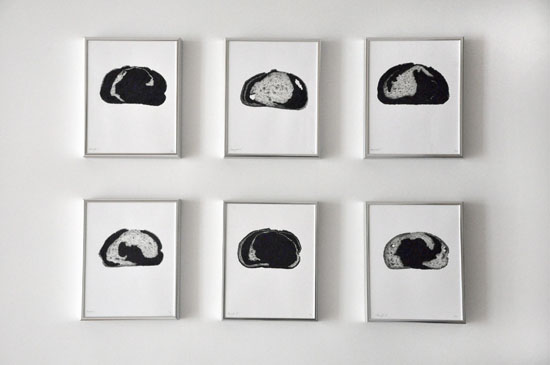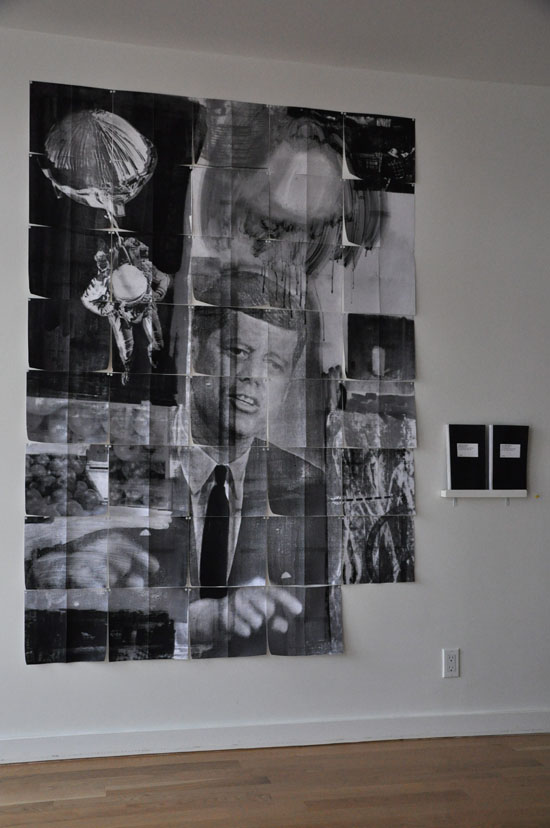In neighborhoods across New York City, from heavily gentrified areas to seedier spots, stand towering, elegant, unsold condominiums. Most were erected before the start of the current US recession — and if it is already tough to sell swanky high-rise lofts to wealthy clientele in Bushwick or Bed-Stuy, doing it during an economic collapse is even harder. Yes, it’s likely that these apartments will attract owners eventually (it is New York, after all). But for the moment, there is square foot upon square foot of underutilized space ripe for the picking.
Enter Super/Prime, an innovative quartet of kids in their early 20s who began mounting art shows in alternative spaces in September of 2009. Harry Gassel, Zach Steinman, Brittany Taylor, and Corwin Lamm met at Oberlin College in Ohio, where they all studied art, writing, or film before flocking east to seek out the collaborative, creative community that is Brooklyn.

These core members, along with a gaggle of friends, recognized a unique opportunity to showcase their work and challenge the public’s idea of what exactly makes a proper art exhibition.
“I don’t think it’s all that political, and I think we’ve all agreed it’s not our place to make that kind of statement directly,” explains Gassel, one of Super/Prime’s organizers. “The motivation is to be able to find whatever opportunities are viable and interesting and maybe have a dialogue with the work, maybe just present really good space, and to bring work together and put on shows.”
So far, the group has held an inaugural show in a Crown Heights condo, participated in the Fountain Art Fair in Miami, curated work in a three-floor residential space in conjunction with a nearby warehouse exhibition in LA, plotted a takeover of a Madison Avenue retail space, and, with any luck, will hold a one-night-only show in a psychic’s storefront.
“A lot of what really good graphic design does is take similar forces and make artwork within confines.”
Currently, its biggest challenge as a collective of young artists is figuring out the level of importance to place on finances — to be or not to be a 501(c)(3)?
“We are casually commercial,” Steinman says. “We’re not a non-profit, but we’re not making a lot of money, so we’re not profitable yet. That’s something we’re still figuring out. Right now it’s just a project that we’re doing.”
Super/Prime’s first show, held at 717 Prospect Place in Crown Heights, Brooklyn, came about when Taylor called a meeting of her artistic friends and co-conspirators. At the time, she was working for Art Observed, a blog with close ties to real-estate firm Tungsten Properties. She revealed that the firm would let the group mount a show in one of its unused condos to generate positive press, and the crew jumped at the chance.
“It seemed great because of the free space, and also the opportunity to at least interact with this thing that was going on in New York — these weird, empty condos, this real-estate boom and bust,” Gassel ruminates. “It felt really present to us. It was nice to not have to make a critique specifically but to be present in that kind of zeitgeist.”

Wanting to avoid a hierarchical structure, all four members cheekily took the title of vice president, and they decided to curate the first exhibition as a group.
“It was a tough meeting,” Gassel says. “Things got heated. The fat was cut by everyone’s strong opinions, and what remained was really strong.” They came up with a final lineup of work by 10 artists, including themselves, acquaintances, and total strangers, entered via a submission process.
One of the pieces in that show was Gassel’s “Six Loaves and Two Point Four Fishes” from his Marble Rye Series, for which he made silkscreen prints of the middle pieces from loaves of the bread in order to highlight the artisan-ship and patterns in a product that can seem so monotonous, especially when compared to white bread.
“I was talking to my grandmother, who completely doesn’t understand my attitude toward abstraction,” Gassel says. “She’s in love with the ’50s and hasn’t really left it, loves the Abstract Expressionists and mid-century furniture and jazz, and just doesn’t look past. I brought her down this imaginary conversation: ‘Picture yourself in the bread aisle of the supermarket, and take away all the plastic from the bread and think about these as sculptures.’ They may not be expressionistic art choices, but at the same time, they do express this really delicate study of form.”
Gassel, who originally hails from New York, is currently enrolled in the MFA program at Yale University to study graphic design. Most of his work is primarily concerned with its own materials — prints about the act of printmaking, designs about design theory.
His commercial endeavors are done under the pig-Latin moniker Eeshirtay (a key indicator of his love for language play). Gassel is quick to point out that his for-profit designs should not be so easily separated from his artistic practice.
“If you look at the fine-art-gallery system and see how people make work specifically for shows, you’re starting to introduce elements of the client or some kind of external force that would drive the work,” he says. “I think fine artwork has always had some of that. A lot of what really good graphic design does is take similar forces and make artwork within confines.”
Some of his bread prints were also shown at the Fountain Art Fair in Miami, Art Basel’s DIY-punk little sister based in hip, downtown Wynwood. The group raised money for a booth there by throwing fundraisers with bands including Silk Flowers and Teengirl Fantasy, and soon enough the four were headed south for one of the country’s biggest clusters of art happenings. For four days, they held court in a warehouse among mostly New York-based galleries like Glowlab, Milk Studios, and Grace Exhibition Space. As Steinman explains, they found it rewarding to show alongside these well-established institutions.
“We’re coming in, basically an unheard-of group of people, and getting a response and developing an identity, which was really interesting as a group,” he says. “It gave us a lot of good momentum, which was probably the most valuable part of going down there.”
In the corner of Super/Prime’s booth stood an unassuming lamp that connected to a stereo. It played “Got Your Money,” the rap anthem by deceased Wu-Tang Clan member Ol’ Dirty Bastard, on loop. Whenever the song’s iconic clap clap rolled around, the lamp would turn on or off, comprising Steinman’s piece, “ODB Clapper Memorial.” With the help of a whiz-kid friend, he hacked into that bizarre piece of Americana, The Clapper, causing it to respond to the song in just the way he wanted.

“What I like about the clapper is I can set it up in 20 different ways, and it runs itself,” he says. “I definitely have a very minimalist approach to using space. Everything has to be really loaded and well chosen. I generally like to keep it as reductive and un-haphazard as possible while still seeming like it could have just fallen there.”
Steinman grew up in San Francisco before heading to Ohio for school and then settling in Brooklyn. Currently, he works as an assistant to artist Wade Guyton, and he has worked at different times for Carroll Dunham, Piotr Uklanksi, and Jean Shin. His artistic practice is centered on balancing the hyper-referential and the extremely ambiguous.
Another of his self-operating “machines” is a 2007 performance piece entitled “Phantasmagoria.” Steinman commissioned 14 of his friends, some of them professional dancers, to stand underneath long, white circular swaths of fabric and do the “Macarena” while wearing black and white outfits with no musical accompaniment until they couldn’t do it any longer.
“I thought of it as the Abu Ghraib of the ‘Macarena’ or something,” he chuckles. Recalling Yoko Ono’s instruction paintings, his creation set strict guidelines and left little room for the performers to improvise. “It’s the ‘Macarena,’ which is the least creative dance you could think of,” he says. “Anyone can do this. I like that it’s the everyman dance and that it was a real fad.”
Now Steinman is creating a large marble engraving with the Washington Redskins logo on it, and he also is making a series of epoxy-resin paintings that are part of an ongoing project using glitter. In addition, he plays synthesizers and a drum machine in a band with friend Sam Haar (called Blondes), and he occasionally DJs under the same name.
Gassel is continuing to study printing methods and creating work around it; similarly, he is hoping to begin making work that involves documenting Super/Prime’s efforts. “There are really interesting ways to string these things together that I’d like to try and make happen,” he says. “Even something as simple as having a tripod in the same place and taking before and after photos — it’s so simple, to see what it looks like and learn from that process.”
For Super/Prime’s next trick, the group is planning to create more focused, site-specific projects that will allow its stable artists the freedom to play with unconventional spaces. What’s most important right now is staying diplomatic and trying to show work by a wide range of artists.
“I think we’re all looking around a lot and trying to ask people to be involved,” Steinman says. But real estate is a fickle industry, and because of its nature, the group is not specifically committed to condos. “It’s a little tricky dealing with these real-estate people because you can never really believe a word they say,” Gassel laments.
“But it’s exciting to have the opportunity to put something on Madison Avenue or in a warehouse in Long Island City and keep reinventing how people are going to look at the work we curate, or art in general, and keep making these surprising things happen, which I think will give the artists and the artwork a great opportunity to surprise itself, the viewers, and the community.”

